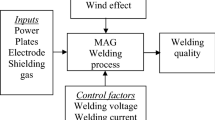Abstract
Chhattisgarh is one of the major rice growing states of India, and paddy is the main crop, cultivated in about 76 % of area under agriculture. Mechanical weed control helps reduce the drudgery involved in manual hoeing. Manufacturing process of paddy weeder involves several operations that are to be performed sequentially, repeatedly, effectively, and hence, emphasis is to perform all the operations more efficiently as well. Jigs were designed with the help of software Solid Works and were then developed at the Faculty of Agricultural Engineering, Raipur. The saving in cost of weeding was 60 %, and saving in time was 65 % compared to manual weeding. The improved jigs facilitated the production in 60 % of time taken by traditional jigs. Taguchi method was used to solve the problems related to improving the yield and productivity. Taguchi’s design of experiments (DOE) helped pin-point the source of yield and increase the yielding efficiency. The DOE based on L8-orthogonal array of Taguchi methodology were implemented. The paper outlines Taguchi methodology to optimize the control factors having high and low settings in the production of paddy weeder. The analysis of the results showed that the optimal combination for minimum time consumption in production process is maximum number of bending with minimum welding operation and minimum number of drilling operations. The optimized process by implementation of Taguchi methodology showed a reduction of 30 % in average production time.











Similar content being viewed by others
References
Antony J, Antony FJ (2001) Teaching the Taguchi method to industrial engineers. Work Study 50(4):141–149
Çiçek A, Kıvak T, Samtaş G (2012) Application of Taguchi method for surface roughness and roundness error in drilling of AISI 316 stainless steel. Strojniški vestnik - J Mech Eng 58(3):165–174
Fowlkes WY, Creveling CM (1995) Engineering methods for robust product design. Addison-Wesley Publishing Company, Reading
Fraley S, Oom M, Terrien B, Zalewski J (2007) Design of experiments via Taguchi methods: orthogonal, arrays. https://controls.engin.umich.edu/wiki/index.php
Fratilia D, Caizar C (2011) Application of Taguchi method to selection of optimal lubrication and cutting conditions in face milling of AlMg3. J Clean Prod 19:640–645
Hosseinzadeh H, Zamini SA, Taheri A (2011) An optimization of new die design of sheet hydroforming by Taguchi method. World Acad Sci Eng Technol 5(2):360–363
Mishra BP, Panday VK, Dwivedi DK (1993) Effect of different weeding methods on energy and economic management under Khura rice cultivation system. All India seminar of Agril. Engineers, Institution of Engineers (India), Jabalpur
Nag PK, Dutt P (1979) Effectiveness of some simple agricultural weeder with reference to physiological responses. J Hum Ergol 8(1):11–21
Phadke MS (1989) Quality engineering using robust design. Prentice-Hall, Englewood Cliffs
Radovanović M, Petković D, Janković P, Madić M (2014) Application of Taguchi method for determining optimum surface roughness in turning of medical stainless steel. In: International scientific conference, 21–22 Nov 2014, GABROVO
Ross P (1988) Taguchi techniques for quality engineering. McGraw Hill, New York
Taguchi G, Chowdhury S, Wu Y (2004) TAGUCHI’S quality engineering handbook. Wiley, Hoboken
Verma A, Sahu RK (2007) Design, development and performance evaluation studies on gender friendly rotary paddy weeder. J Agric Issues 2(2):24–32
Author information
Authors and Affiliations
Corresponding author
Rights and permissions
About this article
Cite this article
Shrivastava, A., Verma, A. Implementation of Taguchi methodology in optimization of developed jigs and fixtures for production of paddy weeder. Paddy Water Environ 15, 1–9 (2017). https://doi.org/10.1007/s10333-016-0522-6
Received:
Revised:
Accepted:
Published:
Issue Date:
DOI: https://doi.org/10.1007/s10333-016-0522-6




